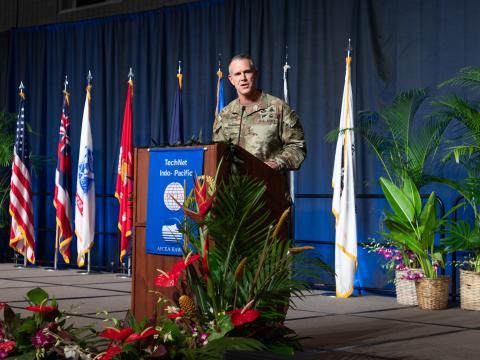Space Development Agency Launches Tranche Zero
The U.S. Space Development Agency (SDA) launched 10 space vehicles this week and plans to add 18 more assets into space in June and then will demonstrate the payload capabilities as part of its greater effort to deploy a comprehensive missile warning system. This so-called Tranche 0 effort is forming the beginning of the transport and tracking layers of the missile warning system that will help the United States track and defend against adversarial missiles, including hypersonic weapons.
As part of the system, a proliferated low-earth-orbit constellation of hundreds of satellites and sensors will connect directly from space to the military’s tactical legacy datalinks, including Link-16, and fire controls of weapons systems. The agency is pursuing two-year iterative capability cycles to “spiral in” innovation, said SDA Director Derek Tournear and Mike Eppolito, Tranche 0 program manager, on a call with reporters on March 29.
This summer, the agency plans to demonstrate beyond-line-of-sight targeting, missile warning/missile tracking, on-orbit fusion, and multiphenomenology ground-based sensor fusion, employing the capabilities from the first two launches. “The [minimum viable product] demonstrates the low latency data transport and missile warning/tracking capabilities of the proliferated warfighter space architecture (PWSA) and enables the warfighter to integrate PWSA capabilities into their planning for future exercises and operations [for] warfighter immersion,” an agency document indicated.
Tournear emphasized the speed at which the agency and stakeholders moved to get to this first launch and deploy the basis of Tranche 0 and the other layers of the warning system that will follow, Tranches 1-3. “These first group of PWSA satellites will launch four years after standing up the agency and just over two years after awarding contracts to build these satellites,” he said.
Of the 28 space vehicles in Tranche 0, 20 will form the mesh satellite communications network, including 14 that are equipped with optical communications terminals (OCTs) and radio frequency (RF) receive and transmit capability, six that have tactical data link receive and transmit capability, and eight that have wide-field-of-view sensor payloads.
The terrestrial component to the system, for now, relies on existing systems, Eppolito noted.
“The ground segment is predominantly operated by the Naval Research Laboratory,” he said. “We also have antennas up in Alaska and in Maryland as well. We've made other smart decisions with our ground segment. We're reusing some antennas. We refurbished those rather than going out and procuring entirely new antennas so we were able to save both some time and some cost from that standpoint. The future tranches will evolve beyond the construct for Tranche 0 that we're using.”
And although the agency had wanted to test Tranche 0 during the Defense Department’s Northern Edge Exercise in Alaska in May, Federal Aviation Administration approval for Link-16 connection was delayed, the officials said. Instead, they will test and check out the initial Tranche 0 assets at Eglin Air Force Base’s test range in the Gulf of Florida, as well as during smaller training exercises in the Indo-Pacific Command’s area of responsibility, including with the Marine Corps.
“When the [tracking satellites] are first up there, they're going to go through a period of calibration,” Tournear explained. “After calibration, then they'll look for targets of opportunity for any kind of launches that we're able to check and track to help get calibration data. The actual test events where we actually fly U.S. systems that we have a designed test against and tracking that will be in spring of '24.”
On the transport side, the agency will participate in “a lot of lower-level exercises that the warfighters are going to participate in to test everything out,” the director continued. “Most of those are on the Link-16 side and we will start out with tests at Eglin’s test and training facility to demonstrate that and really iron out all the bugs and figure out exactly how to do this conductivity with terrestrial Link-16 radios and space.”
With the successful launch, the agency is already looking next to Tranches 1 and 2. Tranche 1 is 18 months out, with launches beginning in late 2024. The Tranche 1 capabilities are currently under the critical design review stage.
Meanwhile, industry input is needed by mid-April on two of the agency’s next solicitations, for the low-Earth orbit LEO tracking layer architecture in Tranche 2 as well as for its Sabre Flight Payloads planned for 2027.
“The Space Development Agency seeks industry feedback on a low-Earth orbit tracking layer architecture that will provide global surveillance and targeting as a service with a 24/7/365 missile warning, missile tracking, and missile defense capability that is integrated for data routing with the Proliferated Warfighter Space Architecture’s Transport Layer,” the agency stated.
The second notice said, “SDA seeks industry solutions for a payload system that will add multiple new mission capability demonstrations to the NExT (experimental testbed) constellation.”
Given the proliferated nature of the constellation, the agency is accounting for potential single point-to-point attacks by adversaries. It is a larger attack that could cause “common node failure,” such as a cyber attack, that Tournear fears the most. However, he added, Wwe take these threats very seriously and we have protections in place for a secure cyber operating environment.”
With an estimated cost of $15 million per space vehicle, the cost for Tranche 0 and its 28 vehicles is under $1 billion, Tournear said.
Of the 28 space vehicles in Tranche 0, 20 will form the mesh satellite communications network, including 14 that are equipped with optical communications terminals (OCTs) and radio frequency (RF) receive and transmit capability, six that have tactical data link receive and transmit capability, and eight that have wide-field-of-view sensor payloads.
The terrestrial component to the system, for now, relies on existing systems, Eppolito noted.
“The ground segment is predominantly operated by the Naval Research Laboratory,” he said. “We also have antennas up in Alaska and in Maryland as well. We've made other smart decisions with our ground segment. We're reusing some antennas. We refurbished those rather than going out and procuring entirely new antennas so we were able to save both some time and some cost from that standpoint. The future tranches will evolve beyond the construct for Tranche 0 that we're using.”
And although the agency had wanted to test Tranche 0 during the Defense Department’s Northern Edge Exercise in Alaska in May, Federal Aviation Administration approval for Link-16 connection was delayed, the officials said. Instead, they will test and check out the initial Tranche 0 assets at Eglin Air Force Base’s test range in the Gulf of Florida, as well as during smaller training exercises in the Indo-Pacific Command’s area of responsibility, including with the Marine Corps.

These first group of Proliferated Warfighter Space Architecture (PWSA) satellites will launch four years after standing up the agency and just over two years after awarding contracts to build these satellites.
“When the [tracking satellites] are first up there, they're going to go through a period of calibration,” Tournear explained. “After calibration, then they'll look for targets of opportunity for any kind of launches that we're able to check and track to help get calibration data. The actual test events where we actually fly U.S. systems that we have a designed test against and tracking that will be in spring of '24.”
On the transport side, the agency will participate in “a lot of lower-level exercises that the warfighters are going to participate in to test everything out,” the director continued. “Most of those are on the Link-16 side and we will start out with tests at Eglin’s test and training facility to demonstrate that and really iron out all the bugs and figure out exactly how to do this conductivity with terrestrial Link-16 radios and space.”
With the successful launch, the agency is already looking next to Tranches 1 and 2. Tranche 1 is 18 months out, with launches beginning in late 2024. The Tranche 1 capabilities are currently under the critical design review stage.
Meanwhile, industry input is needed by mid-April on two of the agency’s next solicitations, for the low-Earth orbit LEO tracking layer architecture in Tranche 2 as well as for its Sabre Flight Payloads planned for 2027.

“The Space Development Agency seeks industry feedback on a low-Earth orbit tracking layer architecture that will provide global surveillance and targeting as a service with a 24/7/365 missile warning, missile tracking, and missile defense capability that is integrated for data routing with the Proliferated Warfighter Space Architecture’s Transport Layer,” the agency stated.
The second notice said, “SDA seeks industry solutions for a payload system that will add multiple new mission capability demonstrations to the NExT (experimental testbed) constellation.”
Given the proliferated nature of the constellation, the agency is accounting for potential single point-to-point attacks by adversaries. It is a larger attack that could cause “common node failure,” such as a cyber attack, that Tournear fears the most. However, he added, Wwe take these threats very seriously and we have protections in place for a secure cyber operating environment.”
With an estimated cost of $15 million per space vehicle, the cost for Tranche 0 and its 28 vehicles is under $1 billion, Tournear said.





Comments